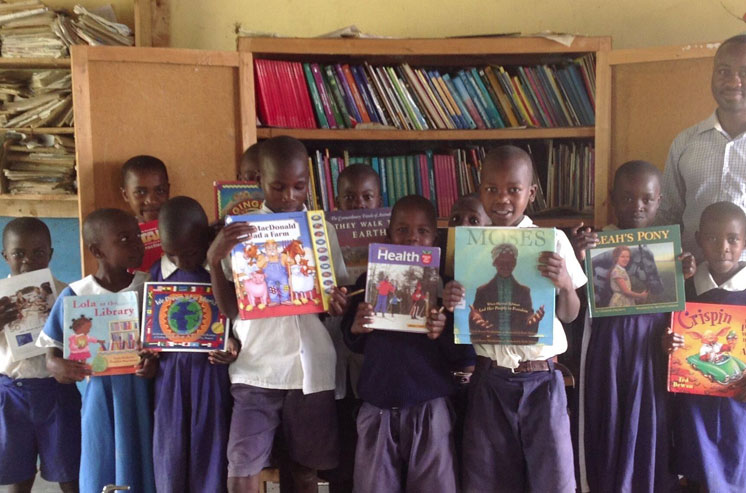In May, a team from the US and Kenya celebrated a landmark event in ALP history—the distribution of ALP’s first container of books for 32 libraries.
It was an important milestone for ALP, but our work in Kenya is not done. We are planning to send a second shipment to Kenya in early 2018 and are currently recruiting book drive organizers who can complete a book drive by December 5.
Click here and help us send a full container to Kenya!
We recently received a report from Project Humanity, our partner that had distributed books for 15 of the libraries located on Rusinga Island. Through visits and conversations with the teacher librarians, they learned how the libraries are being used. One common theme—children love reading the books, and they are requesting MORE BOOKS!
Each library has set up a regular borrowing schedule; some even allow daily borrowing. One school reports that girls are the majority of the borrowers. In another school, the older students borrow books weekly; the younger students read with their teachers in class.

Some readers read at school. One teacher librarian reported that some students come earlier to school so they can start reading before the normal lessons begin. Another told us that “Children are reading most of the time even when it is not reading/library time.” In one secondary school, general reading is on Fridays. “The whole school sits under the trees reading books.”
Of course, the types and subjects of the books enjoyed varying by school and age group. Younger children love colorful, picture books. Primary school students like story books and science books. In one primary school, the boys prefer history and science books; the girls prefer language books. One teacher librarian mentioned that “Children love the books, such as Cinderella.” Many students like short stories and short books best. Some like reference books, like the dictionary.
In one secondary school, health and hygiene books are preferred by the students. In another one, humanities, such as history, geography and religion are students’ favorites.
Teachers, too, use books in libraries. They borrow the books for general reference and use them to teach. The pictures in books can help teachers explain what they are teaching. In one primary school, when a child returns a book, she gives a summary of the story to the teacher librarian.
It has been only 4 months since these libraries were set up, and already they are making a difference for the students and teachers who use them. More book drives will mean more libraries and more impact on African communities.
Start Your Own Book Drive
Read our Book Drive Guidelines to learn all you need to know to collect, sort, pack and then mail your books to our warehouse, where they will be containerized for shipment to Africa. Your goal is to collect 1,000 appropriate books and approximately $500 for shipping and related costs. Double this and you can start two! Triple it and… you get the idea. To get ideas from other book drives — how they’ve collected their books and raised their funds.
We ship books all year round. Our typical calendar is:
- Ghana in February
- Botswana in March
- Malawi in June
- Kenya in July
- Uganda in August
- Lesotho in September
- Sierra Leone in October
- eSwatini (Swaziland) in November

